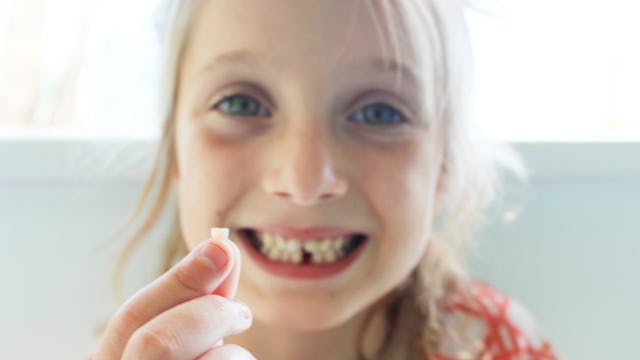Why Some Parents Are Saving Their Kids' Baby Teeth In Tooth Banks

Almost all of us get sentimental when our kids start losing their baby teeth. “Oh my goodness, my baby is growing up,” we think, and then happily play the tooth fairy for the night. But what we do with the actual tooth once we scoop it out from under the pillow definitely varies.
I’m pretty sure the majority of parents just chuck the tooth in the trash, because what the heck are you going to do with your kids’ bloody/gummy tooth monstrosity?
Apparently, though, some parents do save their kids’ baby teeth, most in a little pouch or ziplock. Others go, ummm, a little overboard, and save the teeth in creepy cute little keepsake boxes. Still, others go the extra mile and have the teeth sewn into a stuffed tooth monster doll (I kid you not) or have the teeth made into jewelry (yes, that’s a thing too).
To be honest, I’m not sure I understand the whole saving baby teeth thing, but I recently learned that there actually might be a really good reason to save your kids’ baby teeth – all in the name of your kids’ future health and wellness.
Yup, some parents are saving their kids’ baby teeth in tooth banks in much the same way that people save their baby’s umbilical cord blood in a bank. The idea is that, like umbilical cord blood, baby teeth have stem cells in them that could be used to grow new tissue and organs, or maybe even cure serious diseases down the road.
According to CNN, this practice of “cryopreserving” baby teeth has been around for a decade, but has mostly gained traction in other developed countries outside of the U.S. “It’s based on experimental research that suggests stem cells extracted from the pulp of these teeth might someday regrow a lost adult tooth or offer other regenerative medicine benefits — some potentially life-saving,” CNN explains.
The “experimental” nature of the research might be why it hasn’t become as prevalent a practice as umbilical cord banking – at least as of yet.
“Research is still mostly in the experimental (preclinical) phase,” Ben Scheven, lecturer at the school of dentistry at the University of Birmingham, tells CNN. But Scheven does contend that stem cells from teeth “may provide an advantageous cell therapy for repair and regeneration of tissues,” in the future. Scheven says that these stem cells could rebuild things like bone tissue, retinas, and optic nerves.
Other scientists hypothesize that stem cells from banked teeth could one day cure anything from multiple sclerosis (MS), traumatic brain injury, diabetes – and of course, help regenerate new teeth should you lose your adult teeth (better than dentures, for sure!).
Despite the fact that tooth banking is still in its early stages in terms of research, more and more parents seem to be opting to try it. Kids that are currently diagnosed with serious diseases are good candidates, as are kids who have genetic disorders or diseases that run in their families. And there are just some parents out there who want to take every possible precaution to ensure stellar long-term health for their off-spring.
As Yahoo reports, over 20 tooth banks have opened in the U.S. in the past decade. But tooth storage doesn’t come cheap. At a place like Store-A-Tooth, for example, there is a $1,500 processing fee for baby teeth, and yearly storage rates of about $150, depending on your pricing plan.
I mean, if it could save a life, it’s totally worth it. But I have to say: that’s pretty hefty sum for a freaking tooth.
And then there is the gross factor. As Dr. Jade Miller, the president of the American Academy of Pediatric, describes it to CNN, you have to do some serious pre-planning with your dentist when it comes to securing your kids’ lost teeth for cryopreserving.
“[I]t’s critical that the nerve tissue in that pulp tissue, the nerve supply and blood supply, still remain intact and alive,” Dr. Miller explains. The best baby teeth to preserve, Dr. Miller says, are the teeth kids lose between 5-8 years old – the upper front and bottom teeth (incisors and cuspids). And it’s best to extract the tooth when there’s still about a third of the root attached.
(OMG, I’m seriously gagging at this thought. Ewwwwww.)
“It really requires some planning, and so parents need to make this decision early on and be prepared and speak with their pediatric dentist about that,” says Dr. Miller.
Yeah, well, that’s much more planning (and shelling out of moolah) than I am willing to commit to right now, especially since the research is still in its early stages. So it’s a hard pass from me.
However, I can definitely understand why parents whose kids are living with serious illness would want to do whatever they can for a possible cure, even if it’s a bit of a gamble at this point. Money and gag-factors aside, the whole thing does sound promising in many ways. Who knows—maybe we’ll all be rushing our kids’ precious bloody teeth to the tooth bank sometime in the future.
This article was originally published on